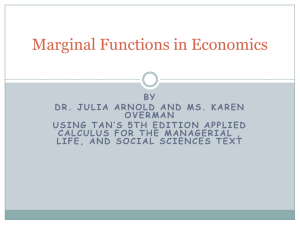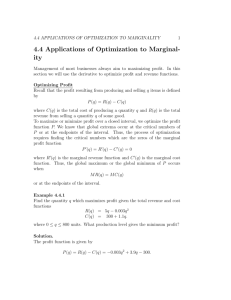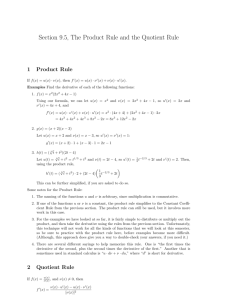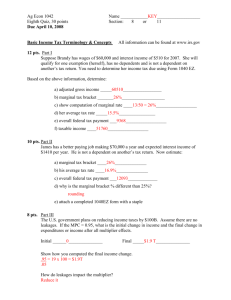Mathematics Review for Economists
advertisement
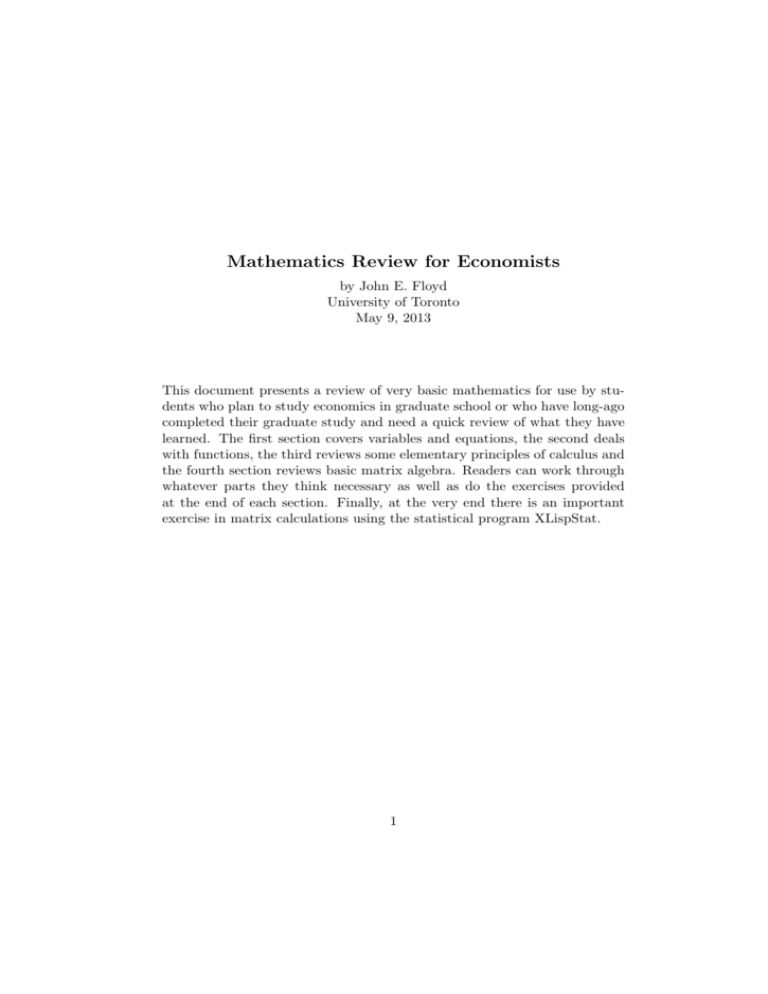
Mathematics Review for Economists by John E. Floyd University of Toronto May 9, 2013 This document presents a review of very basic mathematics for use by students who plan to study economics in graduate school or who have long-ago completed their graduate study and need a quick review of what they have learned. The first section covers variables and equations, the second deals with functions, the third reviews some elementary principles of calculus and the fourth section reviews basic matrix algebra. Readers can work through whatever parts they think necessary as well as do the exercises provided at the end of each section. Finally, at the very end there is an important exercise in matrix calculations using the statistical program XLispStat. 1 3. Differentiation and Integration1 We now review some basics of calculus—in particular, the differentiation and integration of functions. A total revenue function was constructed in the previous section from the demand function Q = α − βP (1) which was rearranged to move the price P , which equals average revenue, to the left side and the quantity Q to the right side as follows P = A(Q) = α 1 − Q. β β (2) To get total revenue, we multiply the above function by Q to obtain T (Q) = P Q = A(Q) Q = 1 α Q − Q 2. β β (3) where Q is the quantity supplied by a potential monopolist who, of course, is interested in equating the marginal revenue with the marginal cost. The marginal revenue is the increase in total revenue that results from selling one additional unit which, as can easily be seen from Figure 1, must equal the slope of the total revenue curve—that is, the change in total revenue divided by a one-unit change in the quantity. The marginal revenue from selling the first unit equals both the price and the total revenue from selling that unit. The sale of an additional unit requires that the price be lower (given that the demand curve slopes downward) and, hence, the marginal revenue is also lower. This is clear from the fact that the slope of the total revenue curve gets smaller as the quantity sold increases. In the special case plotted, where α = 100 and β = 2, total revenue is maximum at an output of 50 units and, since its slope at that point is zero, marginal revenue is also zero. Accordingly, the marginal revenue curve plotted as the dotted line in the Figure crosses zero at an output of 50 which turns out to be onehalf of the 100 units of output that consumers would purchase at a price of 1 An appropriate background for the material covered in this section can be obtained by reading Alpha C.Chiang, Fundamental Methods of Mathematcial Economics, McGraw Hill, Third Edition, 1984, Chapter 6, Chapter 7 except for the part on Jacobian determinants, the sections of Chapter 8 entitled Differentials, Total Differentials, Rules of Differentials, and Total Derivatives, and all but the growth model section of Chapter 13. Equivalent chapters and sections, sometimes with different chapter and section numbers, are available both in earlier editions of this book and in the Fourth Edition, joint with Kevin Wainwright, published in 2005. 2 Figure 1: Total, average and marginal revenue when α = 100, β = 2. zero, at which point total revenue would also be zero. We do not bother to plot the marginal revenue curve where marginal revenue is negative because no firm would produce and sell output under those conditions, given that marginal cost is always positive. The average revenue, or demand, curve is plotted in the Figure as the dashed line. To make the relationship between the demand curve and marginal revenue curve clearer, these two curves are plotted separately from the total revenue curve in Figure 2. The total revenue associated with any quantity is the area under the marginal revenue curve—that is the sum of the marginal revenues—to the left of that quantity. We now state the fact that the derivative of a function y = F (x) is equal to the slope of a plot of that function with the variable x represented by the 3 Figure 2: Demand and marginal revenue curves when α = 100, β = 2. horizontal axis. This derivative can be denoted in the four alternative ways dy dx dF (x) dx d F (x) dx F ′ (x) where the presence of the integer d in front of a variable denotes a infinitesimally small change in its quantity. We normally denote the slope of y with respect to x for a one-unit change in x by the expression ∆ y/∆ x . The expression dy/dx represents the limiting value of that slope as the change in x approaches zero—that is, ∆y dy = ∆x→0 ∆x dx lim (4) The first rule to keep in mind when calculating the derivatives of a function is that the derivative of the sum of two terms is the sum of the 4 derivatives of those terms. A second rule is that in the case of polynomial functions like y = a (b x)n the derivative takes the form dy d d = a (b x)n = a n (b x)n−1 (b x) = b a n (b x)n−1 dx dx dx (5) where, you will notice, a multiplicative constant term remains unaffected. Accordingly, the derivative of equation (3) is the function [ ] d α 1 Q − Q2 dQ β β d 1 2 d α Q− Q dQ β dQ β α 2 − Q β β M (Q) = = = (6) which is the marginal revenue function in Figure 2. The slope of that marginal revenue function is its derivative with respect to Q, namely, d M (Q) dQ d α d 2 − Q dQ β dQ β 2 = 0− β 2 = − . β = (7) which verifies that, when the demand curve is linear, the marginal revenue curve lies half the distance between the demand curve and the vertical axis. Notice also from the above that the derivative of an additive constant term is zero. Since marginal revenue is the increase in total revenue from adding another unit, it follows that the total revenue associated with any quantity is the sum of the marginal revenues from adding all units up to and including that last one—that is Q0 ∑ 0 MR ∆Q = Q ∑ ∆TR 0 ∆Q ∆Q = TRQ0 . (8) When we represent marginal revenue as the derivative of the total revenue curve—that is, as ∆TR dTR = lim ∆→0 ∆Q dQ 5 (9) Figure 3: Total revenue visualized as the sum of sucessive marginal revenues. equation (8) can be rewritten as ∫ Q0 ∫ MR dQ = 0 0 Q0 dTR dQ = TR Q0 . dQ (10) Marginal revenue is the length of an infinitesimally narrow vertical slice extending from the marginal revenue curve down to the quantity axis in the reproduction of Figure 2 above and dQ is the width of that slice. We horizontally sum successive slices by calculating the integral of the marginal revenue function. In the previous section, the effect of the stock of liquidity on the fraction of output that is useable—that is, not lost in the process of making exchange—is a third-degree polynomial term that multiplies the level of the 6 capital stock as follows Y = mKΩ (11) where ( L 1 ϕ−λ Ω=1− 3λ K )3 . (12) The derivative of income Y with respect to the stock of liquidity L takes the form dY dΩ = mK dL dL (13) where, taking into account the fact that ϕ and K are constants, dΩ dL ( ) ( ) 1 L 2 d L ϕ−λ ϕ−λ 3λ K dL K ( ) ( ) 1 d L L 2 dϕ − −λ ϕ−λ λ K dL dL K ( )2 ( ) 1 L d L − ϕ−λ 0−λ λ K dL K ( )2 ( ) L d L ϕ−λ λ K dL K ( )2 ( ) L λ dL ϕ−λ K K dL ( )2 λ L ϕ−λ K K = −3 = = = = = (14) so that dY = mλ dL ( L ϕ−λ K )2 (15) which is a second-degree polynomial function. Since dY /dL is equal to the increase in the final output flow resulting from an increase in the stock of liquidity (or, in a cruder model, money) the above equation can be interpreted as a demand function for liquidity or money when we set dY dL equal to the increase in the income flow to the individual money holder that will result from holding another unit of money. This income-flow comes at a cost of holding an additional unit of money, normally set equal to the nominal interest rate. Also, we need to incorporate the fact that the quantity of money 7 demanded normally also depends on the level of income. It turns out that, under conditions of full-employment, the level of income can be roughly approximated by m K so that, treating some measure of the money stock as an indicator of the level of liquidity, we can write the demand function for money as ( i = mλ λM ϕ− mY )2 (16) where i is the nominal interest rate. A further modification would have to be made to allow for income changes resulting from changes in the utilization of the capital stock in booms and recessions. In any event, you can see that an increase in i will reduce the level of M demanded at any given level of Y and and increase in Y holding i constant will also increase the quantity of M demanded. Suppose now that we are presented with a fourth-degree polynomial of the form y = F (x) = α + β x + γ x2 + δ x3 + ϵ x4 . (17) We can differentiate this following the rule given by equation (5) together with the facts that the derivative of a constant is zero and the derivative of a sum of terms equals the sum of the respective derivatives to obtain F ′ (x) = dy = β + 2 γ x + 3 δ x 2 + 4 ϵ x3 . dx (18) Suppose, alternatively, that we are given the function F ′ (x) in equation (18) without seeing equation (17) and are asked to integrate it. We simply follow for each term the reverse of the differentiation rule by adding the integer 1 to the exponent of that term and then dividing the term by this modified exponent. Thus, for each term dy d = a xn = a n xn−1 dx dx we obtain ∫ n dy dx = a xn−1+1 = a xn . dx n−1+1 (19) (20) Application of this procedure successively to the terms in equation (18) yields ∫ 1 0+1 2 3 4 βx + γ x1+1 + δ x2+1 + ϵ x3+1 1 2 3 4 2 3 4 = β x + γ x + δx + ϵx F ′ (x) dx = 8 (21) which, it turns out, differs from equation(17) in that it does not contain the constant term α . Without seeing (17), we had no way of knowing the magnitude of any constant term it contained and in the integration process in (21) inappropriately gave that constant term a value of zero. Accordingly, when integrating functions we have to automatically add to the integral an unknown constant term—the resulting integral is called an indefinite integral. To make it a definite integral, we have to have some initial information about the level of the resulting function and thereby be able to assign the correct value to the constant term. This problem does not arise when we are integrating from some initial x-value xo and know the value of the function at that value of x. The derivative of the logarithmic function y = α + β ln(x) (22) is dα d d ln(x) 1 β dy = + β ln(x) = 0 + β =β = . dx dx dx dx x x As you can see, the derivative of ln(x) is the reciprocal of x (23) d 1 ln(x) = (24) dx x which is consistent with the fact that the logarithm of a variable is the cumulation of its past relative changes. The indefinite integral of the function F ′ (x) = β x is thus simply β ln(x) . Then there is the exponential function with base e, y = ex , which has the distinguished characteristic of being its own derivative—that is, d x dy = e = ex . (25) dx dx This property can be verified using the fact, shown in the previous section, that → y = ex x = ln(y) . (26) Given the existance of a smooth relationship between a variable and its logarithm, the reciprocal of the derivative of that function will also exist so that, dx d 1 = ln(y) = dy dy y → dy =y dx 9 → dy = ex . dx (27) Of course, we will often have to deal with more complicated exponential functions such as, for example, y = α eβx+c (28) for which the derivative can be calculated according to the standard rules outlined above as dy dx d (β x + c) = α β (β x + c) e (β x + c)−1 dx = α (β 2 x + β c) e β x + c−1 . (29) = α (β x + c) e (β x + c)−1 At this point it is useful to collect together the rules for differentiating functions that have been presented thus far and to add some important additional ones. Rules for Differentiating Functions 1) The derivative of a constant term is zero. 2) The derivative of a sum of terms equals the sum of the derivatives of the individual terms. 3) The derivative of a polynomial where a variable x is to the power n is d n x = n xn−1 . dx In the case of a function that is to the power n, the derivative is d α F (x)n = n α F (x)n−1 F ′ (x) . dx 4) The derivative of the exponential function y = bx is d x b = bx ln(b) dx or, in the case of y = ex , since ln(e) = 1 , d x e = ex . dx In the case where y = eF (x) the derivative is d F (x) e = eF (x) F ′ (x) . dx 10 5) Where y is the logarithm of x to the base e, the derivative with respect to x is dy d 1 = ln(x) = . dx dx x 6) The chain rule. If y = Fy (z) then and z = Fz (x) d Fy (Fz (x)) = Fy′ (Fz′ (x)) . dx 7) The derivative of the product of two terms equals the first term multiplied by the derivative of the second term plus the second term multiplied by the derivative of the first term. d [F1 (x) F2 (x)] = F1 (x) F2′ (x) + F2 (x) F1′ (x) dx 8) The derivative of the ratio of two terms equals the denominator times the derivative of the numerator minus the numerator times the derivative of the denominator all divided by the square of the denominator. [ ] d F1 (x) F2 (x) F1′ (x) − F1 (x) F2′ (x) = dx F2 (x) [F2 (x)] 2 9) The total differential of a function of more than a single variable such as, for example, y = F (x1 , x2 , x3 ) is dy = ∂y ∂y ∂y dx1 + dx2 + dx3 ∂x1 ∂x2 ∂x3 where the term ∂y/∂xi is the partial derivative of the function with respect to the variable xi —that is, the change in y that occurs as a result of a change in xi holding all other x−variables constant. We end this section with some applications of the total differential rule immediately above. An interesting application is with respect to the standard Cobb-Douglas production function below which states that the level of output of a firm, denoted by X, depends in the following way upon the inputs of labour L and capital K Y = A L α K 1−α 11 (30) where α is a parameter and A is a constant representing the level of technology. The total differential of this function is dY = A [K 1−α αL α−1 dL + Lα (1 − α) K 1−α−1 dK] = (A αL α−1 K 1−α ) dL + (A (1 − α) Lα K −α ) dK (31) where you should note that (A αL α−1 K 1−α ) and (A (1 − α) Lα K −α ) are the respective marginal products of labour and capital. The increase in output associated with changes in the labour and capital inputs thus equals the marginal product of labour times the change in the input of labour plus the marginal product of capital times the change in the input of capital. Note also that, using a bit of manipulation, these marginal products can also be expressed as ∂Y ∂L = L A αL α−1 K 1−α α A L α K 1−α Y = =α L L L (32) and ∂Y ∂K = K A (1 − α) L α K −α (1 − α) A L α K 1−α Y = = (1 − α) . (33) K K K Substituting the above two equations back into (31), we obtain dY = α Y Y dL + (1 − α) dK L K (34) which, upon division of both sides by Y becomes dY Y = α dL dK + (1 − α) . L K (35) Actually, a simpler way to obtain this equation is to take the logarithm of equation (30) to obtain ln(Y ) = ln(A) + α ln(L) + (1 − α) ln(K) (36) and then take the total differential to yield ∂ln(L) ∂ln(K) dL + (1 − α) dK ∂L ∂K 1 1 = α dL + (1 − α) dK L K dL dK = α + (1 − α) L K d ln(Y ) = α 12 (37) An important extension of the total differential analysis in equations (31) and (34) is to the process of maximization. Suppose for example that the wage paid to a unit of labour is ω and the rental rate on a unit of capital is κ. The total cost of production for a firm would then be T C = ωL + κK (38) and if the quantity of the labour input is changed holding total cost constant we will have dT C = 0 = ω dL + κ dK which implies that dK = − ω dL κ (39) which, when substituted into the total differential equation (34) yields [ dY = α ] ω (1 − α) Y Y − dL . L κ K (40) Maximization of the level of output producible at any given total cost requires that, starting from a very low initial level, L be increased until a level is reached for which a small change in L has no further effect on output. This will be the level of L for which α ω (1 − α) Y Y − =0 L κ K → α Y ω (1 − α) Y = . L κ K When both sides of the above are divided by (1 − α) Y /K, the expression reduces to ω α (Y /L) = . (1 − α) (Y /K) κ (41) You will recognize from equations (32) and (33) that the left side of the above equation is simply the ratio of the marginal product of labour over the marginal product of capital—otherwise known as the marginal rate of substitution of labour for capital in production. As noted in the Figure below, this ratio is the slope of the constant output curve. Since the right side of the equation is the ratio of the wage rate to the rental rate on capital, the condition specifies that in equilibrium the marginal rate of substitution must be equal to the ratio of factor prices, the latter being the slope of the firm’s 13 budget line in the Figure below. The optimal use of factors in production is often stated as the condition that the wage rate of each factor of production be equal to the value marginal product of that factor, defined as the marginal product times the price at which the product sells in the market. You can easily see that multiplication of the numerator and denominator of the left side of the equation above by the price of the product will leave the optimality condition as stated there unchanged. 14 Figure 4: Cobb-Douglas production function Y = AL.75 K .25 at specific output level. Another concept of interest is the elasticity of substitution of labour for capital in production. It is defined as the elasticity of the ratio of capital to labour employed with respect to the marginal rate of substitution defined as the marginal product of labour divided by the marginal product of capital—that is, the relative change in the capital/labour ratio divided by the relative change in the ratio of the marginal product of labour over the marginal product of capital. The elasticity of substitution in the CobbDouglas production function can be obtained simply by differentiating the left side of equation (41) above with respect to the capital/labour ratio. First, we can cancel out the variable Y and then take the logarithm of both 15 sides and differentiate the logarithm of the marginal rate of substitution with respect to the logarithm of the capital/labour ratio. This yields α K α (Y /L) = (1 − α) (Y /K) 1−α L ) ( ( ) α K ln(MRS) = ln + ln ) 1−α L d ln(MRS) d ln(α)/(1 − α) d ln(K/L) = + d ln (K/L) d ln(K/L) d ln(K/L) d MRS d (K/L) / = 0 + 1 = 1/σ MRS K/L σ = 1 MRS = (42) where σ is the elasticity of substitution, which always equals unity when the production function is Cobb-Douglas. The above result makes it worthwhile to use functions having constant elasticities that are different from unity. A popular function with this characteristic is the constant elasticity of substitution (CES) function which is written below as a utility function in the form [ U = A δ C1−ρ + (1 − δ) C2−ρ ] −1/ρ (43) where U is the level of utility and C1 and C2 are the quantities of two goods consumed. Letting Ψ denote the terms within the square brackets, the marginal utility of C1 can be calculated as ∂U ∂C1 = −A ( [−(1/ρ)−1] ) Ψ (−δ ρ) C1−ρ−1 ρ ( ) −(1+ρ) = A δ Ψ − (1+ρ)/ρ C1 [ = A δ δ C1−ρ + (1 − δ) C2−ρ ] − (1+ρ)/ρ −(1+ρ) C1 . (44) By a similar calculation, the marginal utility of C2 is ∂U ∂C2 [ = A (1 − δ) δ C2−ρ + (1 − δ) C2−ρ ] − (1+ρ)/ρ −(1+ρ) C2 (45) and the marginal rate of substitution is therefore ∂U/∂C1 δ MRS = = ∂U/∂C2 (1 − δ) ( C1 C2 ) −(1+ρ) 16 δ = (1 − δ) ( C2 C1 ) (1+ρ) (46) Figure 5: CES utility function U = A[δ C1−ρ + (1 − δ) C2 −ρ ] −1/ρ at a specific utility level with δ = 0.5 and the elasticity of substitution, equal to 1/(1 + ρ), set alternatively at 0.5, 1.0, and 2.0 . which, upon taking the logarithm, becomes ( δ ln(MRS) = ln 1−δ ) ( C2 + (1 + ρ) ln C1 ) ( C2 = (1 + ρ) ln C1 ) . (47) The elasticity of substitution therefore equals σ= d ln(C2 /C1 ) 1 = d ln(MRS) 1+ρ (48) and becomes equal to unity when ρ = 0, less than unity when ρ is positive and greater than unity when −1 < ρ < 0, becoming infinite as ρ → −1. 17 Obviously it would make no sense for ρ to be less than minus one. Indifference curves with elasticities of substitution ranging from zero to infinity are illustrated in Figure 5 above where δ = .5. It turns out that the Cobb-Douglas function is a special case of the CES function where ρ = 0 , although equation (43) is undefined when ρ = 0 because division by zero is not possible. Nevertheless, we can demonstrate that as ρ → 0 the CES function approaches the Cobb-Douglas function. To do this we need to use L’Hôpital’s rule which holds that the ratio of two functions m(x) and n(x) approaches the ratio of their derivatives with respect to x as x → 0 . m′ (x) m(x) = lim ′ x→0 n (x) x→0 n(x) lim (49) When we divide both sides of equation (43) by A and take the logarithms we obtain ( ln Q A ) = −ln[δC1−ρ + (1 − δ)C2−ρ ] m(ρ) = ρ n(ρ) (50) for which m′ (ρ) becomes, after using the chain rule and the rule for differentiating exponents with base b , m′ (ρ) = [δC1−ρ d −1 [δC1−ρ + (1 − δ)C2−ρ ] −ρ + (1 − δ)C2 ] dρ −[−δ C1−ρ ln(C1 ) − (1 − δ) C2−ρ ln(C2 )] [δC1−ρ + (1 − δ)C2−ρ ] = which, in the limit as ρ → 0 becomes m′ (ρ) = δ ln(C1 ) + (1 − δ) ln(C2 ) . (51) Since n(ρ) = ρ , n′ (ρ) also equals unity, so we have ( lim ln ρ→0 Q A ) = δ ln(C1 ) + (1 − δ) ln(C2 ) m′ (ρ) = ′ ρ→0 n (ρ) 1 lim = δ ln(C1 ) + (1 − δ) ln(C2 ) (52) This implies that Q = A C1δ C21−δ 18 (53) which is the Cobb-Douglas function.2 Exercises 1. Explain the difference between ∆y/∆x and dy/dx . 2. Differentiate the following function. y = ax4 + bx3 + cx2 + dx + g 3. Integrate the function that you obtained in the previous question, assuming that you are without knowledge of the function you there differentiated. 4. Differentiate the function y = a + b ln(x) . 5. Differentiate the following two functions and explain why the results differ. y = a bx y = a ex 6. Given that x = ln(y), express y as a function of x. 7. Suppose that y = a + bz2 z = ex and Use the chain rule to calculate the derivative of y with respect to x . 8. Using the two functions in the previous question, find d (yz) dx and 2 d dx ( ) y z . Every use of L’Hôpital’s rule brings to mind the comments of a well-known economist when asked about the quality of two university economics departments, neither of which he liked. His reply was “You’d have to use L’Hôpital’s rule to compare them”. 19 9. Let U (C1 ) be the utility from consumption in period one and U (C2 ) be the utility from consumption in year two, where the functional form is identical in the two years. Let the utility from consumption in both periods be the present value in year one of utilities from consumption in the current and subsequent years where the discount rate is ω, otherwise known as the individual’s rate of time preference. Thus, U = U (C1 ) + 1 U (C2 ) . 1+ω Take the total differential of the present value of utility U . Let the interest rate r be the relative increase in year two consumption as a result of the sacrifice of a unit of consumption in year one, so that ∆C2 = −(1 + r) ∆C1 Assuming that the individual maximizes utility, calculate the condition for optimal allocation of consumption between the two periods. 10. Calculate the marginal products of labour and capital arising from the following production function. Q = A[δ L −ρ + (1 − δ) K −ρ ] −1/ρ Then calculate the elasticity of substitution between the inputs. How do the results differ then you use the Cobb-Douglas production function instead of the CES production function above? 20

